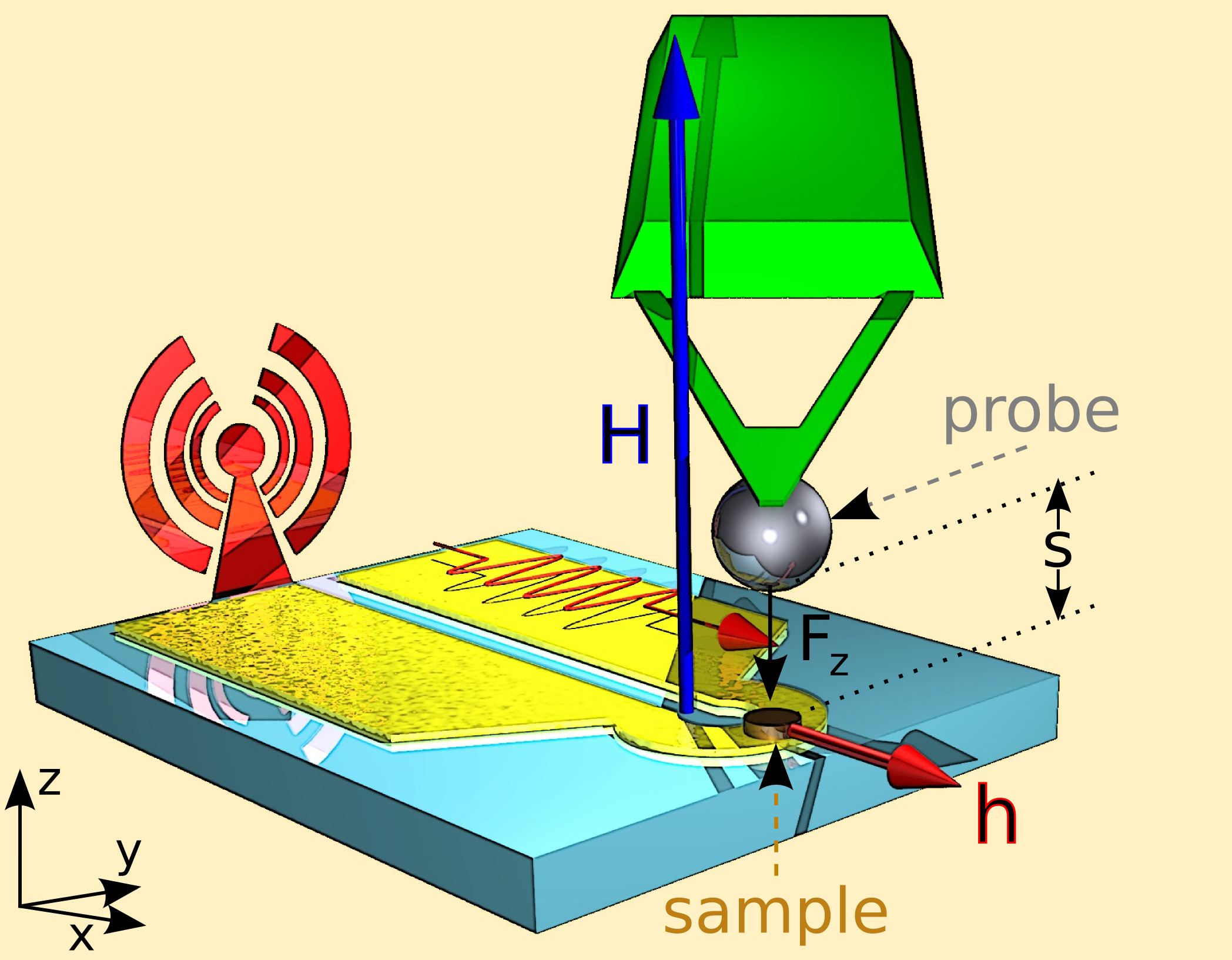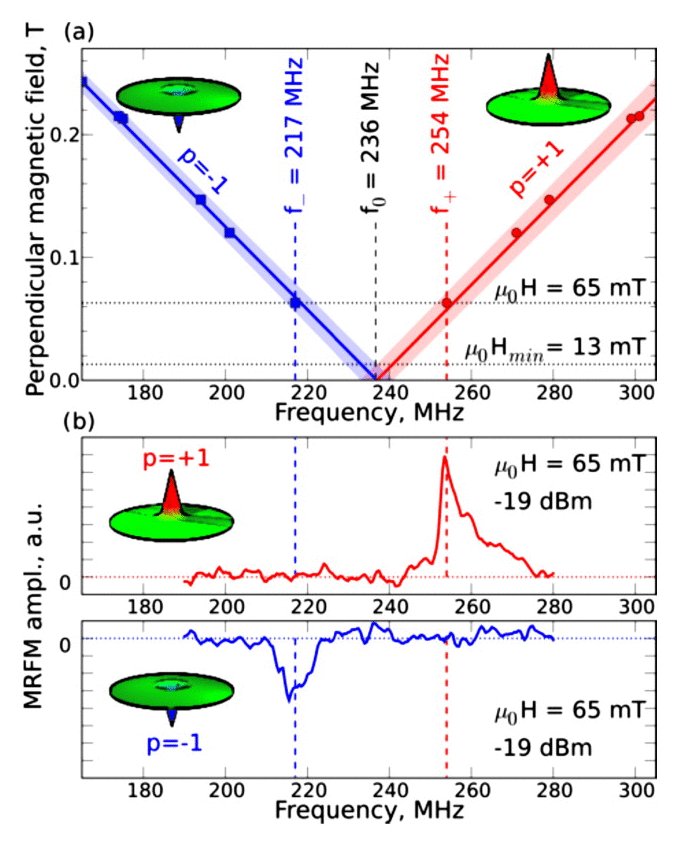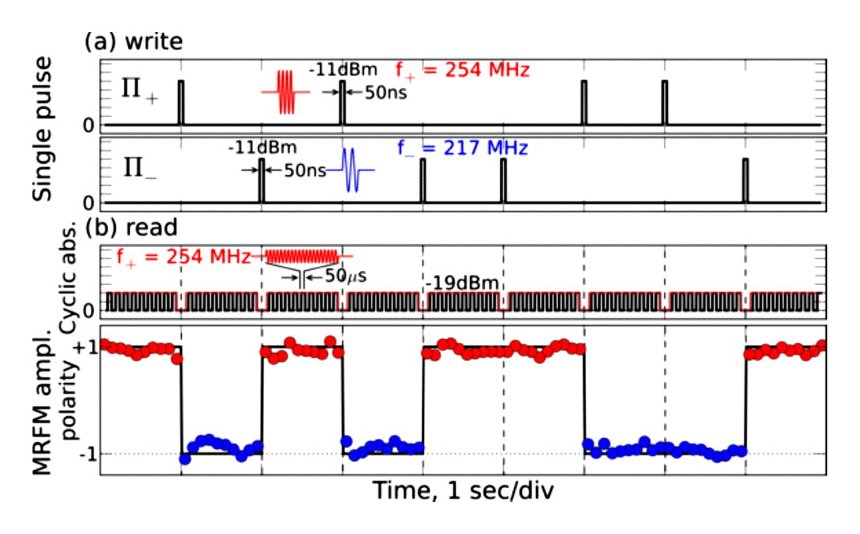|
L'un des objectifs les plus importants des technologies de l'information est le développement de mémoires non-volatiles rapides à haute densité, qui sont économes en énergie, et qui peuvent être produites par les technologies modernes de nanofabrication. De ce point de vue, les nano-objets magnétiques offrent un moyen commode pour stocker l'information binaire à travers leurs propriétés de bi-stabilité. Mais le développement pratique de mémoires magnétiques exige aussi de trouver un mécanisme performant pour inverser l'aimantation à l'intérieur de chaque cellule. Actuellement, l'état vortex d'un nano-disque magnétique fait l'objet de nombreuses études pour la richesse des effets physiques qui sont attachés à sa topologie singulière. Un vortex magnétique correspond à un état d'équilibre où l'aimantation statique tourne dans le plan de manière à minimiser son champ de fuite. Une telle configuration laisse une anomalie dans la région centrale, appelée cœur, où l'aimantation ne peut que pointer hors du plan, soit vers le haut ou soit vers le bas, ces deux états possibles, appelés polarité, étant stables. Des études expérimentales récentes ont montré qu'une inversion dynamique de la polarité d'un vortex était possible en induisant des mouvements de grande amplitude du coeur de vortex. |
|
Les chercheurs de l'IRAMIS/SPEC viennent de montrer qu'en plus du couplage entre polarisation électrique, magnétisme et distorsion du réseau cristallin, l'oxyde BiFeO3 présente un couplage entre éclairement et déformation. Du fait de ces couplages, ce type de matériaux "multifonctionnels" offre la possibilité de commuter, sous l'action d'un signal externe d'une nature donnée (éclairement, contrainte, champ magnétique ou électrique externe), une propriété du matériau de nature différente (aimantation, polarisation électrique, déformation…). La possibilité d'observer l'ensemble de ces couplages (photostriction, électromagnétisme, électrostriction …) dans un même matériau, ouvre la voie à la conception d'une très grande variété de capteurs avec un extraordinaire potentiel applicatif. |
In a vortex-state magnetic nanodisk, the static magnetization is curling in the plane, except in the disk center where it is pointing out-of-plane, either up (polarity p=+1) or down (p=-1). The lowest energy excitation mode of this ground state is the so-called gyrotropic mode [1], corresponding to a gyration of the vortex core around its equilibrium position at the center of the disk. In zero magnetic field, the resonant frequency of this mode is insensitive to the magnetization direction in the core, but the sense of the core rotation is determined by a right-hand rule to its polarity. Recent experiments performed at zero field demonstrated reversal of vortex core polarity through large amplitude excitation of the gyrotropic mode [2]. This dynamical reversal mechanism is of fundamental interest but also has potential application in information technology, with the vortex core polarity coding the binary information.
In order to investigate magnetization dynamics in individual vortex-state nanodisks, we have used the exquisitely sensitive technique of magnetic resonance force microscopy (MRFM), developed in the Nanomagnetism Group of SPEC [3] (see Fig. 1). The studied nanodisks with thickness 44 nm and diameter 1 µm are made of NiMnSb alloy, an ultra-low damping epitaxial material grown in Laurens Molenkamp's group (Würzburg Universität).

|

|
We have first demonstrated that the frequency degeneracy corresponding to the gyrotropic modes with opposite polarities in zero field can be lifted by applying a magnetic field perpendicular to the disk plane [4] (see Fig. 2). This Zeeman-like splitting can be used for a simple reading of the polarity state in an individual nanodisk. In order to discriminate the resonant frequencies f- and f+ associated respectively to the core polarities p=-1 and p=+1, it is necessary to choose the static magnetic field in such a way that the field-induced gyrotropic frequency splitting exceeds the linewidth of the gyrotropic mode. In our experiment, a bias field as small as µ0H=13 mT is sufficient to fulfill this condition. Obviously, the microwave magnetic field employed to read the polarity state must be weak enough, so that the core polarity is not reversed during the reading sequence.
We can also take advantage of this frequency discrimination in order to reverse deterministically the vortex core polarity, as shown in [5]. Starting with the vortex core polarity in, say, the p=+1 state, a single microwave field pulse whose carrier frequency is tuned at f+ and with sufficient amplitude (that we shall call a Π+ inversion pulse) will resonantly excite the gyrotropic motion of the core until it reaches the critical threshold for reversal. Once it has been reversed, the final state p=-1 is out of resonance with the writing pulse, so that it cannot be switched back to p=+1. Similarly, it is possible to write the state p=+1 starting from the p=-1 state using the appropriate Π- pulse (see Fig. 3). This writing process has been shown to be very robust, as no mistake could be recorded out of several hundred attempts with our experimental parameters.

|
In sum, our frequency-controlled magnetic vortex memory prototype has two main advantages. Owing to the frequency discrimination allowed by a small perpendicular bias field, there is no need to control the circular polarization of the microwave field and to precisely time the writing pulse as it has to be in zero field. Also, deterministic and local addressing in a large array of memory cells is easily obtained by using the stray-field of the MRFM probe, that can be scanned laterally. Finally, a series of improvements can be imagined in order to make our memory prototype more practical. In particular, it would be useful to replace the MRFM detection by electrical detectors, and to use a local combination of the static and microwave fields at the intersection of a word and a bit lines to address the binary information in individual cells.
Contact: Dr. Fabien PORTIER
A conductor in equilibrium under a bias voltage shows current fluctuations proportional to its resistance and temperature. This type of noise is known as the Johnson-Nyquist noise, or equivalently, the thermal noise. In a quantum conductor, current fluctuations generate microwave photons which obey chaotic statistics (cf., blackbody radiation) if the conductor is at equilibrium. When the conductor is out-of-equilibrium; however, the stochastic aspect of the electron transport gives rise to different kinds of current fluctuations (quantum shot noise) that muddle the photon statistics. Understanding the link between the statistics of electrons and that of emitted photons is very intriguing as it will reveal the connection between quantum conductors and quantum optics. This problem has recently attracted theoretical interest, and a full spectrum of photon statistics, ranging from chaotic to non-classical, has been predicted [1].
Recently, the Nanoelectronics group at SPEC has performed the first experiments to put theories on test by measuring the statistics of microwave photons radiated by a simplest quantum conductor; a tunnel junction, in the shot-noise regime.
Les expériences de violation d'une inégalité de Bell avec deux objets séparés dans l'espace sont considérées comme la meilleure preuve de la nature intrinsèquement quantique du monde : les états des deux objets peuvent être si intimement liés (les physiciens disent "intriqués") que parler de l'état de chacun d'eux n'a plus de sens, même lorsqu'ils sont très éloignés l'un de l'autre.
Les chercheurs du Groupe Instabilités et Turbulence de l'IRAMIS-SPEC ont montré expérimentalement que la transition de blocage de matériaux granulaires amorphes, qui se traduit par l'apparition d'une rigidité globale, se manifeste par la croissance d'une longueur de corrélation présentant un caractère critique.
(figure de titre : Champ de déplacement au voisinage d'un intrus tiré dans un milieu granulaire dense)
 |
|
|
|
Illustration 1: Schéma de l'expérience. Une particule intruse est tirée à force constante parmi les autres grains. |
Illustration 2: Diagramme d'état, dans lequel deux transitions apparaissent : la transition de fluidification (courbe) et la transition de Jamming (vertical) |
Vous avez un grain? Ils en ont des milliers ! Dans cette expérience du Groupe Instabilités et Turbulences, une assemblée amorphe de grains en 2D est compressée dans une cellule sous vibration horizontale (voir illustration 1) jusqu'à atteindre les états les plus denses possible : une transition apparaît alors, dite transition de blocage (Jamming) [1,2], donnant une rigidité globale au matériau par percolation dynamique des chaines de force.
Les caractéristiques fines de cette transition ont été étudiées au cours de la thèse de Raphaël Candelier au moyen d'une particule « intrus » tirée à force constante dans le milieu. Un diagramme de phase a été dressé, qui met en évidence la présence d'une ligne de fluidification, au dessus de la quelle l'intrus avance sans s'arrêter (comme dans un liquide visqueux) et en dessous de laquelle l'intrus adopte un mouvement intermittent, l'intensité des fluctuations se renforçant au voisinage de la transition de Jamming.
Sous la ligne de fluidification, la réponse à cette perturbation fortement non-linéaire présente une intermittence spatio-temporelle illustrée dans une vidéo : Voir la vidéo
Les images brutes des grains sont représentées dans la partie inférieure, tandis que la partie supérieure montre ces grains après traitement d'image, la couleur codant leur vitesse instantanée. Il apparaît clairement dans cette configuration - très proche de la transition - que le matériau « hésite » entre un état très rigide et un état très fluide. Les réorganisations à longue protée que l'on peut apercevoir dénotent le caractère critique de cette transition qui a été mis en évidence quantitativement par une analyse du type « crackling noise » révélant des lois d'échelles.
Cette phénoménologie, explorée ici expérimentalement par un procédé original, est décrite dans deux publications récentes [3,4].
Du point de vue de leur comportement à la rupture, les matériaux sont traditionnellement regroupés en trois grandes classes :
Les expériences réalisées à l'IRAMIS-SPCSI montrent qu'un même matériau peut, en fonction de la vitesse de fissuration, appartenir à deux de ces catégories : il est observé que le Plexiglas®, archétype des matériaux fragiles, s'endommage au delà d'une vitesse limite bien définie, par nucléation de microfissures, comme les matériaux quasi-fragiles.
